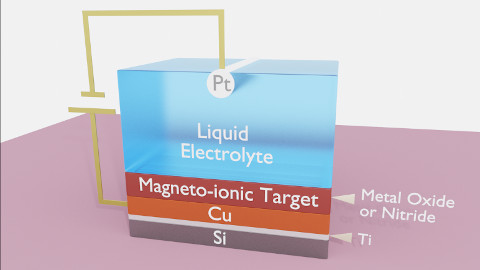
[ad_1]
Magnetic materials are ubiquitous in modern society, present in almost all the technological devices we use every day. In particular, personal electronic devices such as smartphones / watches, tablets and desktop computers all rely on magnetic material to store information. Information in modern devices is stored in long chains of 1s and 0s, in the binary number system used as a computer language.
“If you imagine a magnetic bar, the same one many of us played with as children (and perhaps still do), you may remember that they were labeled with a” north “side and a” south “side (or had two colors on each end. ). If two magnets were brought close to each other, the same sides would repel each other and the opposite sides would attract – two distinct halves that can be easily identified. In this way, a “1” and a “0” can be assigned to the orientation of a magnet, so that a long chain of magnets can be organized in a computer to store data, “explains UAB researcher ICREA Jordi Sort, one of the research coordinators.
Currently, changing the orientation of a magnet (essentially writing or rewriting data) in electronics has been based on using current, the same current needed to power home outlets and charge the phone. But here’s a problem: when you run current through a material, the material heats up. This heat is a form of energy that is lost in the environment, essentially wasted. The demand to store more and more data increases every year and requires the creation of smaller and smaller devices, which exponentially worsens this heating effect, leading to enormous energy losses. Not surprisingly, then, government and private research have turned to the development of new energy-efficient materials and technologies to solve this problem.
One possible solution to this problem is to use magnetic materials that can rely on voltage to reorient the magnetic material, studied in a research field called voltage-controlled magnetism, using voltage instead of current to significantly reduce the energy needed to alter magnetic orientation. There are several approaches, but a promising and popular branch of research in the field explores magneto-ionics, in which non-magnetic atoms are moved in and out of a magnetic material using voltage, thereby altering its magnetic properties.
A recent collaborative study between UAB, Georgetown University, HZDR Dresden, CNM’s Madrid and Barcelona, University of Grenoble and ICN2 and published in the journal Nature Communications has shown that it is possible to activate and deactivate magnetism in nitrogen-containing metals (i.e. to generate or remove all magnetic characteristics of this material) with tension. A simple analogy would be that we are able to completely increase or remove the force with which a magnet attracts, for example, a refrigerator door, simply by connecting it to a battery and applying a certain voltage polarity.
In this project, cobalt nitride has proven non-magnetic per se, but when nitrogen is removed with tension, it forms a cobalt-rich structure that is magnetic (and vice versa). This process has proven repeatable and durable, suggesting that such a system is a promising means of writing and storing data in a loopable fashion. Interestingly, it is also shown that it requires less energy and is faster than systems using alternative non-magnetic atoms, such as oxygen, increasing possible energy savings.
Research paper:
Julius de Rojas, Alberto Quintana, Aitor Lopeandía, Joaquín Salguero, Beatriz Muñiz, Fatima Ibrahim, Mairbek Chshiev, Aliona Nicolenco, Maciej O. Liedke, Maik Butterling, Andreas Wagner, Veronica Sireus, Llibertat Abad, Christopher J. Jensen, Kai Josep Nogués, José L. Costa-Krämer, Enric Menéndez & Jordi Sort, Tension-Driven Movement of Nitrogen ions: A New Paradigm for Magneto-Ion, Nature Communications (2020). DOI: 10.1038 / s41467-020-19758-x
.
[ad_2]
Source link